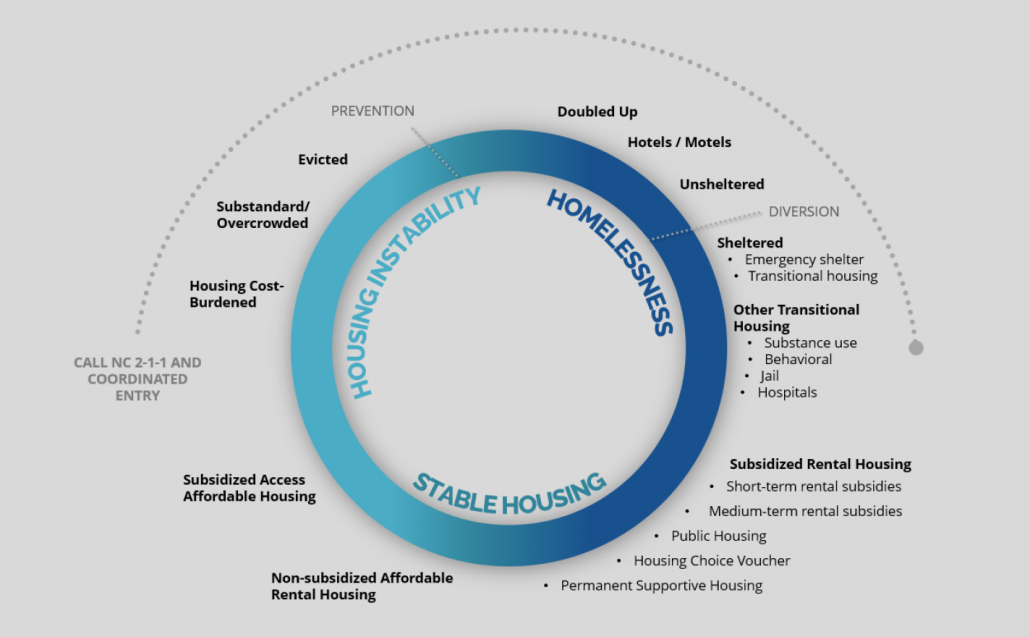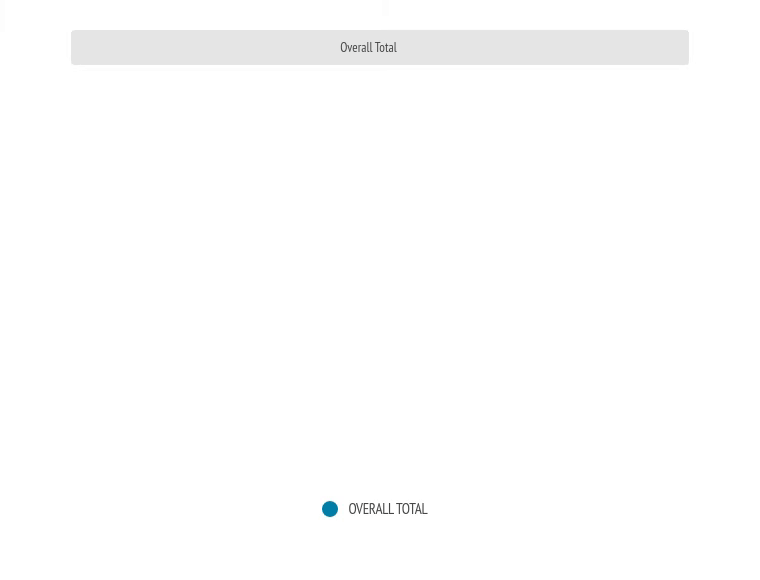Courtney LaCaria
Housing & Homelessness Research Coordinator
Mecklenburg County Community Support Services
Launched last year, the Housing & Homelessness Continuum Data Update is one part of the continuous improvement program supporting our progress from a focus on the Point-in-Time Count, One Number, and other disparate data sources; to reliance on a more comprehensive and inclusive data set that reflects the full continuum of need, from housing instability to homelessness.
The One Number is a monthly census that includes all sheltered, and a portion of unsheltered, homelessness. The One Number has itself been subject to continuous improvement methodologies. However, even with the advances made to enumerating homelessness using the One Number, there remain many households who experience housing instability and homelessness but who are not captured in the data inputs. It is critical to identify the households “in the gap” to both understand the full need for services, and to construct effective solutions to address these needs.
This shift is also articulated as a need within the A Home for All Strategic Framework: identifying and closing the remaining gaps in data collection and reporting across the full housing continuum. To that end, this week’s blog will provide the latest updates regarding both housing instability and homelessness for the data sources we currently have; and highlight the areas in which gaps still exist; as well as the work underway to address those gaps. Finally, the blog will share what the latest trends show, and what all of this could mean for Charlotte-Mecklenburg.
Housing & Homelessness Continuum: the Latest Data
The graphic depicted below helps visualize the interrelationship of all the components comprising the full housing continuum. Immediately following are definitions for housing instability and homelessness. Finally, a table is provided with the latest system-level metrics.
Housing Instability
Housing Instability is a type of housing status. It exists along the housing and homelessness continuum. Housing instability can occur when an individual or household experiences any of the following: living in overcrowded and/or substandard housing; difficulty paying rent or mortgage; experiencing frequent moves due to personal economic or affordability reasons; doubling up with family or friends; or living in hotels. Cost-burden is frequently used as a measure of housing instability. Many people who become homeless have first faced housing instability.
Housing Instability Data
The chart below provides the latest data on housing instability using available system-level approximations.
Current Data Gaps
- Total number of households facing informal evictions
- Total number of households in substandard/overcrowded housing
- Total number of households facing foreclosure
- Total number of households on the Housing Choice Voucher waiting list
- Total number of households experiencing housing instability and seeking assistance for housing
Housing Instability Trends
The chart to the right provides the historical change of the number of people experiencing housing instability and seeking housing assistance through NC 2-1-1 and Coordinated Entry. NC 2-1-1 is defined as a “health and human services information and referral system, provided by United Way, that operates 24/7/365.”
Linked with NC 2-1-1, Coordinated Entry is considered Charlotte-Mecklenburg’s portal to connect individuals and families who are experiencing housing instability or homelessness to all available resources. Therefore, the number of households seeking assistance through Coordinated Entry approximates the households who are experiencing housing instability and who might be most at risk for homelessness. It is important to note that this number, which is reported on a quarterly basis, only captures the number of individuals who reached out to NC 2-1-1 and/or Coordinated Entry for assistance.
The number of callers who were at-risk of homelessness and seeking housing assistance jumped significantly during FY 2021 (July 2020 – June 2021), which corresponds with the first year of the pandemic. Compared with the two previous fiscal years, the number of callers who were at-risk of homelessness increased by more than 1,500. There are already 703 callers who were at-risk of homelessness and seeking housing assistance during the first half of FY 2022. This number exceeds the annual totals for pre-pandemic FY 2019 and FY 2020. Of the 703 callers seeking housing assistance during the first two quarters of this fiscal year, 84% (or 592) have been referred to a prevention assistance navigator.
To access additional data regarding the number of people seeking housing assistance through NC 2-1-1 and Coordinated Entry, click here.
Homelessness
Homelessness is another type of housing status that exists along the housing instability & homelessness continuum. Homelessness simply means the loss of housing. Homelessness can occur when a household lacks a fixed, regular, and adequate nighttime residence. This can include doubling up with family and/or friends; paying to stay week to week in hotels/motels; temporarily residing in a shelter and/or transitional housing facility; experiencing unsheltered homelessness; exiting an institutional setting within a set period after previously experiencing homelessness; and/or fleeing domestic violence. Each agency and funding source describes homelessness differently.
Homelessness Data
The chart below provides the latest data on homelessness using available system-level approximations.
Current Data Gaps
- Total number of households experiencing homelessness in doubled up situations and/or in paying to stay in hotels/motels
- Total number of households experiencing nsheltered homelessness throughout the year
- Total number of households experiencing sheltered homelessness staying in a facility provided by a non-HMIS provider
- Total number of households experiencing other forms of homelessness, including in other forms of Transitional Housing and/or in substance use, behavioral health residential treatment
facilities, jails, and/or hospitals
Homelessness Trends
The chart to the right provides the historical change in One Number totals, the most comprehensive enumeration in our community at this time. This includes month-over-month changes in the total number of people experiencing homelessness and counts of single individuals; families; unaccompanied youth; Veterans; and people experiencing chronic homelessness.
Despite the slight decreases observed between January and June 2021, there has been a 43% (or 879 person) increase in overall homelessness since June 2020. As context, it is important to note that, during this period and in response to COVID-19, the community’s temporary shelter capacity has increased; this added capacity includes the provision of hotel rooms as shelter. This data clearly reflects the ongoing need for housing assistance resulting from the fallout of the pandemic.
To read more about the latest trends and analysis as well as deep dives into disaggregated data by race, ethnicity, age and gender, click here.
SO, WHAT
Enumerating the people who need housing assistance across the entire housing continuum is difficult. A lack of standard definitions is just one facet of why the work is complicated. Significantly, the ways in which homelessness are (and are not) described have political and funding implications. However, failing to name and count all the forms of homelessness does not mean that they don’t exist.
In fact, it is essential that communities, like Charlotte-Mecklenburg, have the fullest possible picture to quantify need; estimate cost; secure funding; implement solutions; and evaluate results. Having this information will help communities respond more quickly in times of crisis, as with the pandemic; or in times of opportunity, such as with the influx of funding to address COVID-related concerns.
Knowing who is actually in need, and where those individuals and families are situated along the housing instability and homelessness continuum, is absolutely critical to the success of any effort, especially a coordinated one. Having access to this data will allow for not only maximizing new American Rescue Plan Act (ARPA) dollars, but all the other public and private resources focused on ending and preventing homelessness in Charlotte-Mecklenburg.
So, how can communities like ours start closing the data gaps that exist across the housing continuum?
One place to start is to acknowledge and embrace a broad definition of homelessness. Doing so ensures that everyone, regardless, of how their homelessness experience manifests, is counted (and therefore, potentially, resourced). It also enables our community to capture the full landscape of services and providers, so that we can see which definitions are being served by what agency, and as a result, where the gaps are.
Then we can begin to standardize processes among providers across the continuum. An example is having all providers integrate, as part of their regular intake process, the same survey questions regarding an individual’s homelessness experience. Like the Point-in-Time Count, providers can then agree to share this information for a specific period of time. Even one night would be a start.
It is important to note that there are limitations to this approach: currently, there is no single, shared database in which individual-level data elements (such as name and birthdate) are entered for all providers across the continuum. This means it would be difficult, if not impossible, to ensure that there is no duplication. It is also likely to be an undercount if the data is limited to one night. However, this simple step could ultimately facilitate the collection of another common data point on homelessness. It would also take tentative steps toward providing a framework for a more accurate estimate of everyone experiencing homelessness. Enumerating the people is critical to ensuring a stable Home for All.
If your organization is interested in learning more about how (or why) to do this, please email Courtney.LaCaria@mecknc.gov.
SIGN UP FOR BUILDING BRIDGES BLOG
Courtney LaCaria coordinates posts on the Building Bridges Blog. Courtney is the Housing & Homelessness Research Coordinator for Mecklenburg County Community Support Services. Courtney’s job is to connect data on housing instability, homelessness and affordable housing with stakeholders in the community so that they can use it to drive policy-making, funding allocation and programmatic change.




